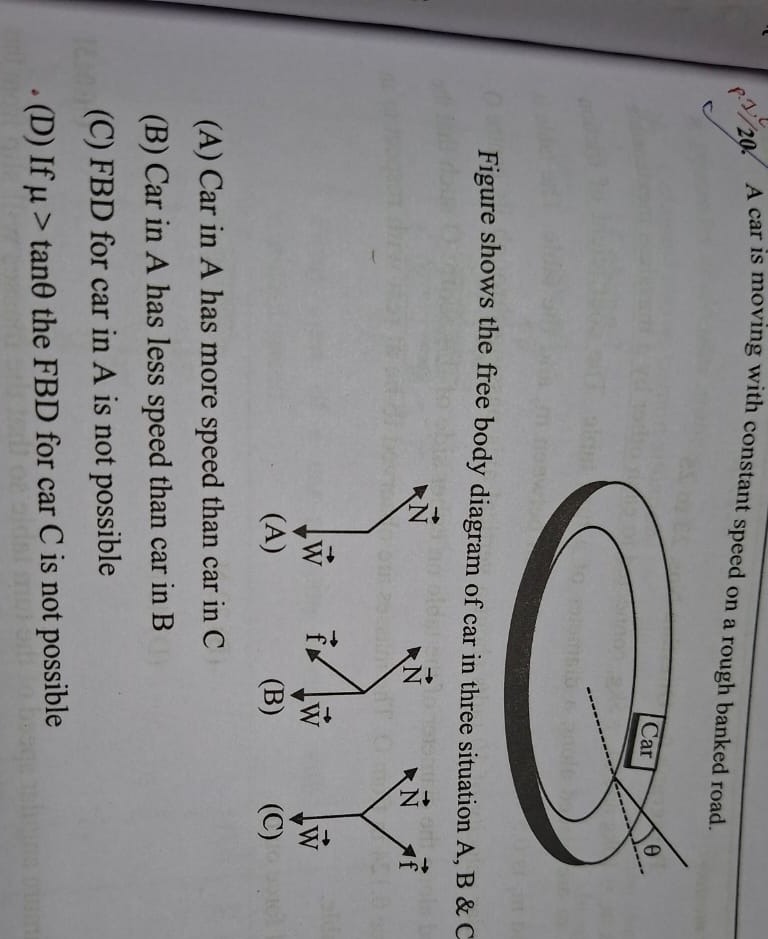Question
Question: A car is moving with constant speed on a rough banked road. Figure shows the free body diagram of c...
A car is moving with constant speed on a rough banked road.
Figure shows the free body diagram of car in three situation A, B & C

Car in A has more speed than car in C
Car in A has less speed than car in B
FBD for car in A is not possible
If μ > tanθ the FBD for car C is not possible
If μ > tanθ the FBD for car C is not possible
Solution
The problem analyzes the forces acting on a car on a rough banked road. We need to determine the correctness of the given statements based on the free-body diagrams (FBDs) and the conditions for motion on a banked road.
Let v0=gRtanθ be the critical speed where banking alone provides the centripetal force and friction is zero.
FBD (A): Friction is directed downwards. This occurs when the car's speed vA>v0. For downward friction, the condition for not slipping downwards (with maximum friction f=μN) is: Nsinθ−μNcosθ≥RmvA2 The vertical equilibrium condition is: Ncosθ=mg+μNsinθ N(cosθ−μsinθ)=mg N=cosθ−μsinθmg For a positive normal force N, we need cosθ−μsinθ>0, which means cotθ>μ, or tanθ>1/μ. If tanθ<μ, then cosθ−μsinθ<0. In this case, even with maximum upward friction, the net horizontal force would not be enough to provide the centripetal force. However, for downward friction, the condition for not slipping upwards is: Nsinθ−fcosθ≥RmvA2 The vertical equilibrium is: Ncosθ+fsinθ=mg With maximum downward friction f=μN: Ncosθ+μNsinθ=mg N(cosθ+μsinθ)=mg N=cosθ+μsinθmg The centripetal force condition becomes: cosθ+μsinθmgsinθ−cosθ+μsinθμmgcosθ≥RmvA2 cosθ+μsinθmg(sinθ−μcosθ)≥RmvA2 For vA2 to be positive, we need sinθ−μcosθ>0, which means tanθ>μ. So, FBD (A) is possible if tanθ≥μ. If tanθ<μ, FBD (A) is not possible.
FBD (C): Friction is directed upwards. This occurs when the car's speed vC<v0. For upward friction, the condition for not slipping downwards (with maximum friction f=μN) is: Nsinθ+μNcosθ≥RmvC2 The vertical equilibrium condition is: Ncosθ=mg+μNsinθ N(cosθ−μsinθ)=mg N=cosθ−μsinθmg For a positive normal force N, we need cosθ−μsinθ>0, which means cotθ>μ, or tanθ>1/μ. If tanθ≤1/μ (i.e., μ≥cotθ or μ≥1/tanθ), then cosθ−μsinθ≤0. This means that even with maximum upward friction, the car will slip downwards. Therefore, if tanθ≤1/μ, FBD (C) is not possible. This is equivalent to saying: If μ≥cotθ, FBD (C) is not possible. Or, if μ>tanθ, FBD (C) is not possible.
Now let's evaluate the options:
(A) Car in A has more speed than car in C: FBD (A) implies vA>v0. FBD (C) implies vC<v0. If both FBDs are possible, then vA>v0>vC, so vA>vC. However, both FBDs may not be possible simultaneously depending on μ and θ. For example, if tanθ<μ, FBD (A) is not possible. Thus, this statement is not always true.
(B) Car in A has less speed than car in B: FBD (A) implies vA>v0. FBD (B) implies vB<v0. So, vA>v0>vB, which means vA>vB. The statement claims vA<vB, which is false.
(C) FBD for car in A is not possible: This statement is true only if tanθ<μ. It is not universally true for all possible values of μ and θ.
(D) If μ>tanθ the FBD for car C is not possible: As derived above, if μ>tanθ, then tanθ<1/μ. This condition makes the minimum speed vmin for upward friction not real, meaning upward friction is not possible. Therefore, FBD (C) is not possible. This statement is correct.
The question asks for the correct statement. Statement (D) is a correct conditional statement about the impossibility of FBD (C) under a specific condition.
